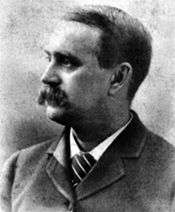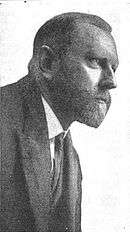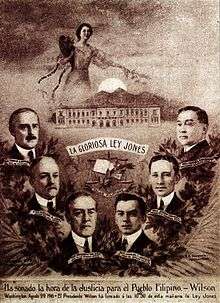Dean Conant Worcester
| Dean Conant Worcester | |
|---|---|
 | |
| Born |
October 1, 1866 Thetford, Vermont |
| Died |
May 2, 1924 (aged 57) Manila, Philippines |
| Resting place |
Pleasant Ridge Cemetery, North Thetford, Vermont[1] 43°50′39″N 72°11′09″W / 43.844183°N 72.185824°WCoordinates: 43°50′39″N 72°11′09″W / 43.844183°N 72.185824°W |
| Citizenship | United States |
| Fields |
Zoology Public official businessman |
| Institutions | University of Michigan, Philippine Insular Government |
| Alma mater | University of Michigan |
| Notes | |
Dean Conant Worcester, D.Sc.(hon.), FRGS (October 1, 1866 – May 2, 1924) was an American zoologist, public official, and authority on the Philippines, born at Thetford, Vermont, and educated at the University of Michigan (A.B., 1889). He first went to the Philippines in 1887 as a junior member of a scientific expedition, and built a controversial career in the early American colonial government beginning in 1899 based upon his experience in the country. He served as the influential Secretary of the Interior of the Philippine Islands until 1913 when he began focusing on his business interests. He died in the Philippines having organized and managed businesses that included coconut farming and processing, cattle raising and a maritime shipping line.[2]
Early life and education
Dean Conant Worcester was born 1 October 1866 in Thetford, Vermont to Ezra Carter Worcester (1816-1887) and Ellen Hunt (Conant) Worcester (1826–1902). He had deep ancestral roots in Puritan New England.[1] Worcester entered the University of Michigan in October 1884, and he was part of the 1887–1888 zoological expedition to the Philippines organized by Joseph Beal Steere in which they collected over 300 zoological specimens, of which 53 were deemed new to science. He graduated with a bachelor's degree in zoology in 1889.[2] Shortly thereafter in September 1890, Worcester and fellow zoologist Frank Swift Bourns returned to the Philippines on a two-year zoological expedition funded by Louis F. Menage, a wealthy Minneapolis businessman who was the major benefactor of the Minnesota Academy of Natural Sciences.[3][4]
Public service in the Insular Government of the Philippine Islands

When the Spanish–American War broke out in 1898, Worcester was very quick to capitalize on his first-hand knowledge of the Philippines by engaging in public lectures and establishing himself as a leading authority on the country with his October 1898 publication of his Philippine Islands and their People.[2] Worcester was an avid photographer during his time in the Philippines and his published photographs had a profound influence in shaping public opinion in the United States about the "exotic" Filipinos.[5]
On 20 January 1899, Worcester was appointed by President McKinley as a member of the Shurman Commission (First Philippine Commission) to make recommendations on how the U.S should proceed after the sovereignty of the Philippines was ceded to the United States by Spain by the Treaty of Paris (1898). He was again appointed on 16 March 1900 by McKinley as the only member from the Schurman Commission to serve on the successor Taft Commission (Second Philippine Commission) where he served until 1913. As a member of the Philippine Commission, he simultaneously served in the highly influential role of Secretary of the Interior for the Insular Government.[6] In this capacity he oversaw the founding of a number of agencies, including the Bureau of Agriculture, Bureau of Science, Bureau of Government Laboratories and the Bureau of Health. In 1907, he founded the Philippine Medical School and in 1908 laid the cornerstone of the Philippine General Hospital, which opened in 1910 and has become the primary teaching hospital for the University of the Philippines College of Medicine and a hospital for the poor.[2][7]
Worcester had a keen interest in public health, but his response to a major 1902–04 outbreak of cholera in Manila and other Philippine cities was highly criticized. The epidemic was particularly severe in the district of Farola in Manila (near present-day San Nicolas) that was home to many of the city's poorest. Worcester ordered the burning of hundreds of houses and forced quarantine of many frightened and homeless Filipinos.[2] Despite these draconian measures taken by Worcester and public health officials, 109,461 people died in Manila and elsewhere in the Philippines. Failure to effectively control this major outbreak and subsequent cholera outbreaks in 1905 and 1908 were major embarrassments for Worcester and drew the ire of the Philippine press often claiming that the public health measures were primarily aimed at clearing slums for the redevelopment of the valuable Manila seaport area.[2] In response, the Insular Department of Interior, primarily under the authorship of Worcester, published a history of these cholera outbreaks with an account of the agency's attempts to control them.[8]
Aves de Rapiña
On October 30, 1908, El Renacimiento, a daily newspaper in Spanish, published an editorial written by Fidel A. Reyes (1878–1967), its city editor, titled Aves de Rapiña (Birds of Prey), which denounced an American official for taking advantage his office in exploiting the resources of the country for his personal gains.[9] Although the editorial did not mention names, Worcester felt that he was the public official referred to and filed a libel case against Reyes, as well as Teodoro Kalaw and Martin Ocampo, the editor and publisher, respectively, among several others. The lower court sentenced Ocampo to six months imprisonment and a fine of ₱2,000 and Kalaw to twelve months imprisonment and ₱3,000 fine and a verdict for moral and punitive damages for ₱25,000. The defendants appealed to the Supreme Court of the Philippines, which affirmed the decision of the lower court[10] and to the Supreme Court of the United States of America, which sustained the decision of the Philippine tribunals.[11] However, Ocampo and Kalaw did not spend a day in jail because Governor-General Francis Burton Harrison pardoned them in 1914 after Worcester left public office in September 1913.[2]
Post-government and business career
In 1911 while serving as Secretary of the Interior, Worcester published a monograph Coconut Growing in the Philippine Islands in which he analysed the farming technology and economics of plantation culture of coconuts for production of copra and oil.[12] By 1914 this publication had become a standard reference for investors interested in coconut products, and the passage of the Payne–Aldrich Tariff Act (1909) and the opening of the Panama Canal (1914) made for a favorable economic climate for importation of Philippine products, including coconut oil, to the industrial centers of the East Coast of the United States. Beginning in 1908, in his capacity as Secretary of Interior, Worcester acquired large tracts of lands in Bukidnon for the use by large-scale agribusinesses. After resignation from public service, he became more involved in the operations of the American-Philippine Company (AMPHILCO) and its three subsidiaries in which he was an investor: the Insular Transportation Company, the Bukidnon Plantation Company and the Visayan Refining Company. Considerable American investments were being made in these companies.[2]

Despite Worcester's resignation from public office, Worcester remained as a focus of Filipino animosity largely for his unfavorable depiction of Filipinos in The Philippine Islands and Their People and his high-profile public opposition of the 1912 and 1914 "Jones Bills" that were eventually passed by the United State Congress as the Jones Act of 1916 that restructured the Insular Government and began a process for full Philippine independence. On 24 July 1915, a popular protest broke out in Cebu in which Worcester was denounced as the coconut agribusiness company manager, demanding his replacement. And in early 1916, Philippine Nationalist Maximo M. Kalaw, wrote an editorial in the Cebu newspaper El Precursor titled "Mr. Worcester and the Filipinos must part forever" in which he asserted that the Cebu protests were like the protests against George III if early Americans were presented to the British public as mostly Indian savages that were incapable of self-government.[13] At issue according to Kalaw was that Worcester had published in 1914 The Philippines Past and Present in which he again used the power of his photography to depict "primitive" Filipinos juxtaposed with photos of the modern infrastructure brought by the Americans, particularly during his own tenure as Secretary of the Interior. But the protests against Worcester subsided in late 1916 once the Jones Act was passed into law and the coconut oil exports were beginning to substantially fuel the local economy in Cebu.[2] Historians Rodney J. Sullivan and Michael Culinane have both pointed out that this later muted response toward American businesses in Cebu was largely because some of the leading families such as the Osmeñas and the Kalaws themselves were major beneficiaries of the economic development brought by Worcester and the other Americans.[2][14]
In 1914, Worcester also had become involved in the cattle ranching operations at the Diklum Ranch (another subsidiary of AMPHILCO), a 10,000 hectare tract of grasslands on the Bukidnon Plateau in Manolo Fortich, Bukidnon, near the port city of Cagayan de Oro.[2] Cattle ranching began in Bukidnon in the mid-1900s from stock originally imported from Texas,[15] but Worcester had taken what had been learned from experiments undertaken by the Bureau of Agriculture to crossbreed cattle from different parts of the world, including the zebu from India for better performance and disease resistance in a tropics. He also had close relations with Dr. William Hutchins Boynton (1881–1959) the chief veterinary pathologist with the Philippine Bureau of Agriculture who by 1918 had developed an early vaccine for rinderpest, a devastating disease of cattle.[16][17][18] In addition to the corporate Diklum Ranch, Worcester also managed his own ranch located in Barangay Dalwangan, Malaybalay.[15] With Worcester's scientific approach to cattle ranching, the business became highly profitable and provided enough supply to greatly diminish cattle imports from as far away as China and Australia that had been occurring since the Philippine–American War had reduced cattle production by as much as 90%.[2]
Worcester died on 2 May 1924 in Manila due to heart disease, and was buried at his hometown of Thetford, Vermont[1] In the reports of his death the Manila newspapers El Debate and Manila Times recognized his shortcomings as a public official and political polemicist but acknowledged that he was an outstanding entrepreneur and major contributor to the three Philippine businesses of coconut farming and processing, cattle ranching and seagoing transport.[2][19]
Selected publications
His publications include, besides various papers:
- The Philippine Islands and Their People (1898)
- The Non-Christian Tribes of Northern Luzon (1906)
- The Philippines Past and Present (two volumes, 1913; new edition, 1914)
References
- 1 2 3 "Dean Conant Worcester". findagrave.com. Retrieved 21 March 2015.
- 1 2 3 4 5 6 7 8 9 10 11 12 13 Sullivan, Rodney J. (1991). Exemplar of Americanism: The Philippine Career of Dean C. Worcester. Michigan Papers on South and Southeast Asia No. 36, Center for South and Southeast Asian Studies, University of Michigan, Ann Arbor. 395pp ISBN 0891480609.
- ↑ Bourns, Frank Swift; Dean Conant Worcester (1894). "Preliminary Notes on the Birds and Mammals Collected by the Menage Scientific Expedition to the Philippine Islands." The Minnesota Academy of Natural Sciences at Minneapolis, Minn. Occasional Papers (Harrison & Smith) 1 (1): 10–11.
- ↑ Minutes of the June 10, 1890 & July 2, 1890 Meetings of the Trustees of the Minnesota Academy of Natural Sciences, IN: Bulletin of the Minnesota Academy of Natural Sciences, Volume 3.
- ↑ Christopher Capozzola. "Photography and Power in the Colonial Philippines -- 2 Dean Worcester's Ethnographic Images of Filipinos (1898-1912)". Massachusetts Institute of Technology MIT Visualizing Cultures. Retrieved 21 March 2015.
- ↑ Patrick M. Kirkwood (Fall 2014). "Michigan Men' in the Philippines and the Limits of Self-Determination in the Progressive Era". Michigan Historical Review. 40 (2). Retrieved 2014-11-04.
- ↑ "Philippine General Hospital History 1900–1911. by John E. Snodgrass MD". Bureau of Printing, Insular Government of the Philippines, Manila. 1912.
- ↑ Philippines. Dept. Of The Interior. 1909. A History Of Asiatic Cholera In The Philippine Islands. Indiana: Philippines. Dept. Of The Interior. A History Of Asiatic Cholera In The Philippine Islands, Manila: Bureau Of Printing. 344pp.
- ↑ "Martin Ocampo Obituary". El Renacimiento, Manila. 26 January 1927. Retrieved 23 March 2015.
- ↑ "G.R. No. L-57 December 24, 1909". The LawPhil Project.
- ↑ "MARTIN OCAMPO and Teodoro M. Kalaw, Plffs. in Err., v. UNITED STATES U.S. Supreme court Decision". Legal Information Institute. 24 May 1914. Retrieved 28 March 2015.
- ↑ Dean Conant Worcester (1911). Coconut Growing the Philippine Islands. United States Bureau of Insular Affairs,31pp.
- ↑ Kalaw, Maximo Manguiat. (1916). The Case for the Filipinos, p.163–167 The Century Company, New York. web version
- ↑ Culinane, Michael. (1982). "The Changing Nature of the Cebu Urban Elite in the 19th Century." pp. 251–296 In: A.W. McCoy and Ed.C. deJesus (eds.), Philippine Social History: Global Trade and Local Transformations. Asian Studies Association of Australia, Southeast Asian Publication Series No. 7, Ateneo de Manila University Press, Quezon City. ISBN 9710200062
- 1 2 Lao, Mardonio M (1987). "The economy of the Bukidnon Plateau during the American Period". Philippine Studies. 35 (3): 316–331.
- ↑ "Cattle Industry Discussed Before Chamber". Journal of the American Chamber of Commerce, Philippines. August 1922. p. 17.
- ↑ "William Hutchins Boynton Obituary". Veterinary Science Department, University of California, Davis. Retrieved 21 March 2015.
- ↑ Boynton, W.H. (1918). "Use of organ extracts instead of virulent blood in immunization and hyperimmunization against rinderpest". Philippine Journal of Science. 13 (3): 151–158.
- ↑ Manila Times 4 May 1924.
External links
| Wikisource has the text of The New Student's Reference Work article about Dean Conant Worcester. |
| Wikimedia Commons has media related to Dean Conant Worcester. |
- Works by Dean Conant Worcester at Project Gutenberg
- Works by or about Dean Conant Worcester at Internet Archive
- American-Philippine Relations: A Guide to the Resources in the Michigan Historical Collections (Article with Dean Conant Worcester) by Thomas Powers
- Dean Conant Worcester at Find-a-Grave
-
 "Worcester, Dean Conant". New International Encyclopedia. 1905.
"Worcester, Dean Conant". New International Encyclopedia. 1905.
